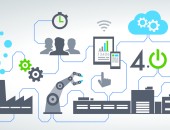Digital transformation of work
Why is the German Social Accident Insurance (DGUV) interested in the way the world of work is changing and the innovations that result from digitalisation?
The future world of work will be even more digital, more flexible and more interconnected. It is going through a sweeping digital transformation which includes, or is leading to, new forms of work and working conditions, new technological developments in Industry 4.0, and a growth in networking. These far-reaching changes create opportunities and risks for workers and put the social security system to the test. This development is often connected with the term ‘Work 4.0’.
This page provides an overview of the activities that the Social Accident Insurance in Germany and its institutions are undertaking as part of these far-reaching developments.
Social dialogue
Ongoing developments in the world of work (especially in 2020), including the necessary social measures, show that traditional forms of work and employment are increasingly changing or even being phased out. Society’s acceptance of these alternative forms of work and employment is growing and proving to be very timely in terms of technological progress, work-life balance and sustainability. These developments are accompanied by regulatory proposals put forward by policymakers. The Social Accident Insurance in Germany is keeping a close eye on these developments and is currently discussing modern forms of prevention to ensure safe and healthy work both today and in the future.
The White Paper ‘Work 4.0’ published in 2016 by the German Federal Ministry of Labour and Social Affairs (BMAS) summarises the conclusions of a social debate in which the DGUV was heavily involved. Since then, the BMAS has drawn on the work already done and launched the ‘New Work – New Security’ Dialogue that covers four key areas – the welfare state, social security, digitalisation and skills development (for more, see Outcomes Report). In 2020, the BMAS also researched the prevalence and impact of mobile work and working from home; it subsequently published the results in a report (German only). In the same year, the BMAS launched the Artificial Intelligence Observatory.The focus of this think tank is the trustworthiness of AI applications – a topic which the Institute for Occupational Safety and Health of the DGUV (IFA) is also working on.
- Trend Search and Risk Observatory
- What are the current trends in the world of work? What opportunities and risks are associated with current and upcoming changes? How can occupational safety and health manage these? And where is there a particular need for action? These and other questions are answered by the IFA Risk Observatory (five-year cycle), which is supplemented/underpinned by the one-year cycle of the "New Forms of Work“ Expert Group Trend Search.

- Remote work
- The digital transformation and the resulting advances in communication and information technologies are expanding the possibilities for remote and flexible work. The Corona pandemic has meant that working outside the traditional workplace has ...

- New forms of work
- In addition to traditional employment relationships, a number of new forms of work are emerging, including atypical forms of work. These include microtasking, crowd working and coworking spaces. Microtasking and crowd working are forms where ...

- New Technologies
- During Industry 4.0, new technologies such as collaborative robots and 3D printing are changing existing forms of work or creating new ones. These offer new opportunities for safety and health at work, but also challenges...

- Acquiring skills and competences
- Digitalisation places growing demands not only on workers’ qualifications, but also on new methods of teaching and learning. The DGUV offers its members information and training on this subject, as well as special e-learning applications for use in blended...
Contact

Dr Nina Gottselig
Safety and Health Department
New forms of prevention
Tel.: +49 30 13001-4507
E-Mail
Downloads

New Forms of Work. New Forms of Prevention. Work 4.0: Opportunities and Challenges
Further information

